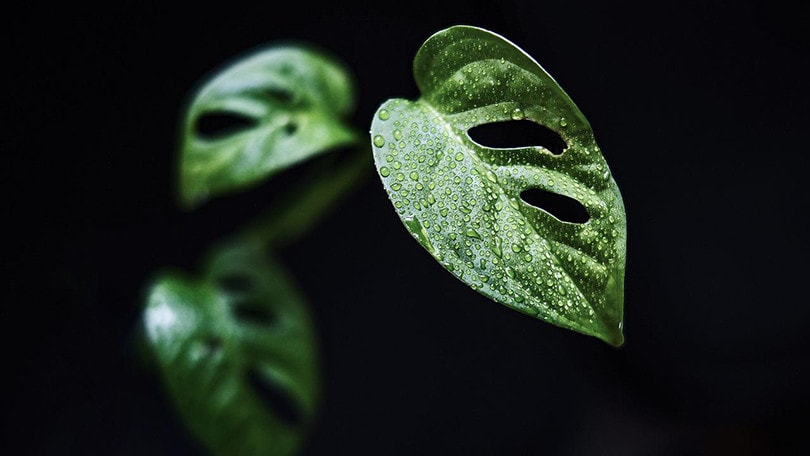How Fast Do Monstera Plants Grow Indoors? Facts & Care Tips
-
Brooke Bundy
- Last updated:

The Monstera plant naturally lurks in Central American rainforests. Growing conditions and the particular species determine whether the Monstera crawls along the forest floor or towers above the other plants, sometimes reaching an enormous height of up to 60-70 ft. tall. In America, they’re typically grown as dense and lush indoor houseplants, although they’ll tolerate outdoor temperatures in USDA zones 10-12. How fast your Monstera plant grows depends on sunlight, fertilizer, and variety. However, rest assured that your houseplant probably won’t ever achieve a height greater than 10-15 ft., even if it’s the bigger Deliciosa species.
Monstera Plant Facts & Features
| Common Name: Monstera |
| Scientific Name: Monstera deliciosa, Monstera Albo, Monstera Peru, Monstera Dubia |
| Type: Evergreen, tropical houseplant |
| USDA Zone: 10-12 |
| Sunlight: Bright, indirect |
Fondly called by many names such as the “Swiss cheese plant,” “split leaf philodendron,” “Mexican Breadfruit,” and “The Hurricane Plant,” the Monstera plant has garnered quite a reputation. There are four main species of Monstera that are usually used as houseplants: Deliciosa, Albo, Peru, and Dubia. Deliciosa is the most popular by far. Its large, branching leaves are a vibrant shade of green, and the plant may even produce creamy flowers in midsummer if grown outdoors. Its leaves are characterized by thick fronds that are commonly depicted in tropical patterns on fabric and other materials.
If left unhindered, Monstera Deliciosa grows the largest of all species. It can reach up to 60-70 ft. in its native rain forests or can climb up to 10-15 ft. tall in your living room if you give it something to climb. Otherwise, its growth will shift horizontally. It can reach up to 6 ft. wide!
The other Monstera species look distinctly different from Deliciosa. Albo is the closest, with the main difference being the white albino appearance of its leaves. This is the most expensive Monstera houseplant, which ranges from $100 for a cutting to well over $1,000 for a mature plant. Peru and Dubia don’t have fronds on their leaves, and they are much smaller species that’ll only reach about 3-8 ft. tall as a houseplant when fully grown.
It’s important to note that all Monstera species are listed as toxic to dogs and cats. To protect your pets, you’ll want to grow your Monstera in a room where they don’t go, or you might want to consider another houseplant as a safe alternative such as a Boston fern or orchid.
How to Care for Your Monstera Plant

Monstera plants need continual growth to thrive. Stagnating plants could be a sign that the plant is diseased, dying, or malnourished. Here’s the best way to care for your Monstera Deliciosa to encourage optimal growth (and prevent it from overtaking your living room):
- Water-Monstera prefers moist conditions, but dislikes excessively soggy soil. To create this environment, provide an adequate drain hole in the bottom of your pot. You should water your plant when the top 2-3 inches of the soil are dry. This will probably be about every 7-14 days, but always water as needed to prevent the soil from completely drying out.
- Place in indirect sunlight-An east-facing window is ideal so it can soak up the early morning rays and not scorch its leaves. However, the west or south window will do as long as it’s not directly in harsh afternoon rays. A north-facing window or room without a window probably won’t provide adequate light for bright, healthy leaves and ample growth.
- Fertilize-Most houseplants originated as tropical plants in the wild that absorbed nutrients through the rich soil on the forest floor. When grown in pots, houseplants quickly deplete the nutrients in the soil and require those elements to be replenished in the form of fertilizer for them to healthily grow. You can fertilize the plant up to twice a month in place of watering with a 20-20-20 water-soluble fertilizer at a rate of 1/2 teaspoon per gallon of water. Once the pot is nearly overflowing with fertilizer and soil, let it drain and repeat twice more.
- Stake-You probably want to encourage your Monstera to grow upwards by securing it with a stake, unless you want a bulging mass of leaves spreading horizontally across your living space. Monstera will grow quite tall on its own, but it’s actually a vining plant and a natural tendency to spread out. If you have a smaller species such as a Dubia, you can let it meander through a trellis if you want to see it really thrive.
In Conclusion
You can expect anywhere from 1-2 ft. of annual growth from your Monstera plant in ideal indoor conditions with plenty of water, food, and sunlight. Monstera receives most of its growth between spring and fall, but houseplants sometimes don’t acknowledge seasonal changes due to climate-controlled housing. You should stake your plant to encourage vertical growth; otherwise, it might overtake its intended area. If it is not growing, it’s probably dying, so make sure you provide your plant with everything it needs to thrive and live a long life.
Featured Image Credit: 20750684, Pixabay
